
Seabird program seeds successes
A profile of Stephen Kress
By Lori Valigra
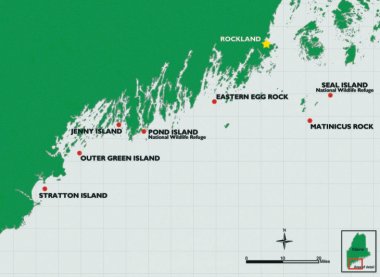 |
| COURTESY: STEPHEN KRESS The seven Maine seabird islands with camps to monitor birds. |
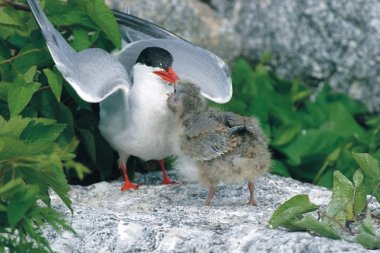 |
| PHOTO: BILL SCHOLTZ A common tern chick needs open space to beg for food. |
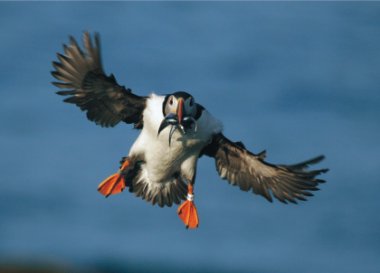 |
| PHOTO: BILL SCHOLTZ After a successful food run, an Atlantic puffin prepares to land and enjoy a meal. |
Low, nasal moans like the sounds of a distant chainsaw hum through the speakerphone, prompting a cat napping nearby to snap to full alert. “We try to use non-aggressive courtship calls,” explained Stephen Kress, the voice on the other end of the telephone line. “Terns like a low moaning sound, and puffins, a growl.” Kress, and the cat, had just demonstrated the effectiveness of bird calls piped through a speaker.
Sounds, mirrors and decoys are just some of the means Kress, who is manager of the National Audubon Society's Maine Coast Seabird Sanctuaries and visiting fellow at the Cornell Lab of Ornithology, uses to lure endangered or threatened birds like roseate, common, Arctic and least terns, as well as Atlantic puffins, back to some of Maine's coastal seabird islands.
There are about 350 such seabird islands off the coast of Maine, 300 of them already occupied by various gulls, which ornithologists like Kress largely blame for the declining tern and puffin populations. The gulls expertly overtake habitat and food sources, driving away other species. Humans have been the other major menace, hunting seabirds for food, bait and fashion feathers through the 1800s and early 1900s. With tern and puffin populations having plummeted, Kress and others over the past several decades have started programs to restore the birds and expand their range. Some of the main projects are through Project Puffin and the Gulf of Maine Seabird Working Group. Kress and his colleagues, who are involved in both groups, are working on 13 islands, but focusing on the seven with field camps: Stratton Island, Outer Green Island, Jenny Island, Pond Island, Eastern Egg Rock, Seal Island and Matinicus Rock.
“Without management, most of the rare species would not be found in the Gulf of Maine,” said Kress, who is renowned for his Scottish knit cap and gentle nature with birds. Hunting by man stopped in the early 1990s, so the primary threat now is the presence of large populations of herring and black-backed gulls, which occupy most of the quality habitat. Terns and puffins live scattered along the Maine coast. Kress said there have been no extinctions, but colonies have been lost or dispersed and the range of population has been greatly narrowed. “We're trying to learn how to expand and reestablish ranges. We look at where the birds nested historically.” One important source of information, Ralph S. Palmer's seminal “Maine Birds,” published by Harvard's Bulletin of the Museum of Comparative Zoology in 1949, also is a book Kress credits with firmly implanting the “birding bug” in him. His other memorable experience: identifying his first bird, a flicker, in the fourth grade in Ohio.
Since Kress and his colleagues started their work, there have been improvements in tern and puffin populations. For example, there are 113 roseate tern nesting pairs on Eastern Egg Rock alone, and 219 total pairs on the monitored islands (up from an estimated 195 in 2005). But much work remains to be done. And it's not what most people would deem pleasant work. Students on the seven islands live in barebones camps starting in the spring through the summer and get bombarded - quite literally - with all sorts of sounds, behavior and matter. Some birds dive-bomb at threats. Terns also pummel their habitat with guano (bird droppings), so much as to cause overgrowth of their nesting areas. The bird islands also smell, attracting predators such as mink swimming from several miles downwind. “All terns are loud and aggressive to chase away predators. We're after people who think this is paradise,” Kress said of enlisting the student volunteers.
Squatters' rights
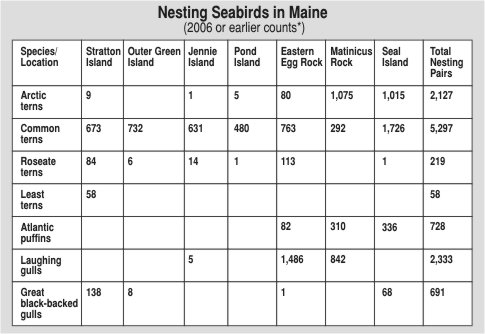 |
| *SOURCE: Stephen Kress (Numbers denote islands with field camps; total nesting pairs include Little Duck, Ten Pound Island, Western Egg Rock and Ross Island) |
One of the most formidable tasks the students and researchers face is keeping away the gulls from tern and puffin habitat. Birds that migrate the farthest away are at the greatest risk to lose habitat. Most gulls don't migrate, and they nest early in the year, in April, so they can have eggs by May. That puts at a disadvantage roseate terns, which migrate to Brazil; common terns, which head to Argentina; and Arctic terns, which fly to Africa and then Antarctica. The terns return mid-May, when the gulls are well established on the islands.
Several techniques have been used to discourage gulls. One of the more successful ones is having humans get onto the islands early in the spring, which tends to keep gulls away. Another method that met with mixed results was using avicide, a chemical put on bread to kill the gulls. Kress said the gulls learned to avoid the bread. Having people on the islands early and preparing for the other seabirds to return has worked in many cases, as the gulls seem to dislike humans. Trapping mink and other intruders also is a must.
Since terns need to nest in the open, the student volunteers also must clear the islands of overgrowth. Typically ocean waves would clear out vegetation, but because of the large amount of rich tern guano, the overgrowth must be managed by humans. One method that has met with success is laying down large pieces of black plastic to kill off the growth.
Once the habitat is cleared as much as possible of prey and overgrowth, the researchers use techniques Kress pioneered during Project Puffin, a 34-year-old National Audubon Society program under which puffin chicks were transported from Newfoundland to Eastern Egg Rock, about six miles offshore of New Harbor in Muscongus Bay, in mid-coast Maine. The treeless island is about seven acres (three hectares) large, and is the site for Project Puffin's first reintroduction program for puffins in 1973. Kress and his team had received permission from the Canadian Wildlife Service to collect the chicks for more than a decade and then transport them to Eastern Egg Rock. At Eastern Egg, they inserted them into prepared burrows and fed them small fish by hand each day while serving as surrogate parents. Since puffin chicks migrate alone and not with their parents as do tern chicks, it was possible to relocate them with the hope they would find their way back to their new homestead. The scientists placed wooden puffin decoys and mirrors to trick the birds into thinking they had a companion and lure the birds back to the island. Finally, in 1977 puffins started returning to the island, and in 1981 four pairs nested in burrows on Eastern Egg Rock. Today, there are 82 nesting pairs.
Natural selection?
Kress readily admits the birds rely on human intervention. Humans clear the brush, scare off predators, even supply companions such as decoys, which terns mount and whose beaks puffins peck. The mirrors, mating sounds blared over speakers and the staged nesting places for terns - flat and dry areas are preferred - all have a human hand. Even with the help, the terns may be their own worst enemies.
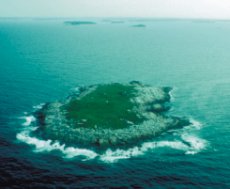 |
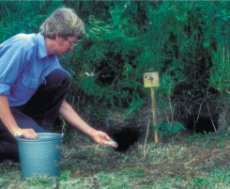 |
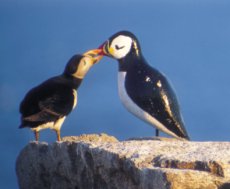 |
COURTESY: STEPHEN KRESS |
COURTESY: STEPHEN KRESS Feeding Atlantic puffins in artificial burrows. |
COURTESY: STEPHEN KRESS |
“The newest piece of this story is that over time, the puffin colonies continue to increase steadily,” Kress said. “But the tern colonies are almost self-limiting, even with the protective sites. The terns degrade their own habitat and are more likely to attract predators.” The biggest problem is the guano, which has a dramatic effect on spurring the growth of invasive plants. Bird guano is a rich, nitrogen fertilizer, so the plants grow high. “This is a problem because the terns require open spaces. Tern chicks need to dry out when they are wet and beg for food in the open,” Kress said. That means more plant burning by humans and using plastic to kill the vegetation.
“Our success leads to problems and new challenges,” he added. “As a colony grows it becomes more attractive to predators. The islands have scents and can be smelled downwind.” Three summers ago a mink swam two miles to Outer Green Island, where it killed a large number of terns. The mink was trapped, but the damage was done. What had been a colony with 1,000 pairs of terns fell to a population of about 700 terns last summer, Kress said.
For birds that destroy their own habitat and need humans to survive, would it make more sense to let natural selection take its course? It's a question Kress says has been asked, but to which he states a firm, “No.”
“Humans are responsible as stewards. These species have disappeared because of human actions,” he said. “This is no longer a natural ecosystem. Humans have affected everything. We need to own up to that.”
For more on Kress's work and on Maine seabirds visit:
http://www.projectpuffin.org/
http://www.birds.cornell.edu/
http://www.mainebirding.net/
http://www.fws.gov/endangered/
Lori Valigra is editor of the Gulf of Maine Times.
© 2007 The Gulf of Maine Times